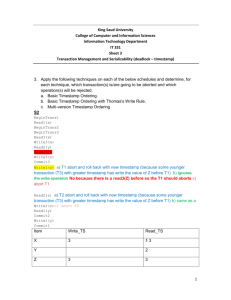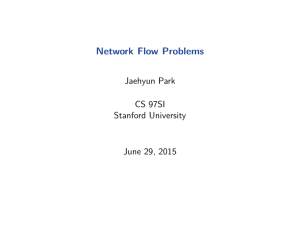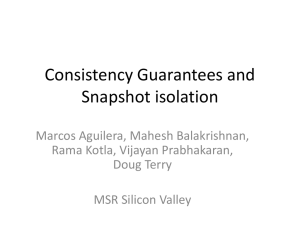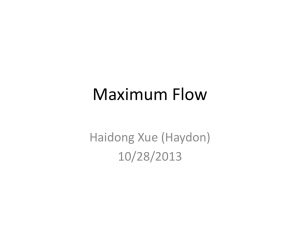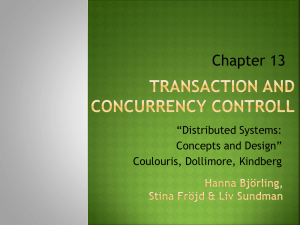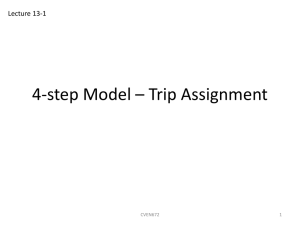3 - Stanford Computer Science
advertisement
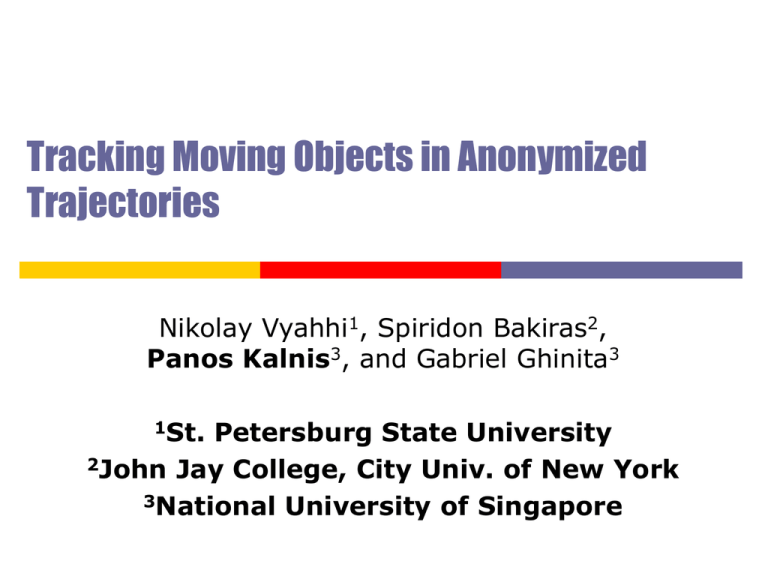
Tracking Moving Objects in Anonymized Trajectories Nikolay Vyahhi1, Spiridon Bakiras2, Panos Kalnis3, and Gabriel Ghinita3 1St. Petersburg State University 2John Jay College, City Univ. of New York 3National University of Singapore Motivation Collection of Trajectory Data Example: Traffic monitoring system Data expected to be anonymous GPS or Sensors deployed across a city Queries: Predict traffic conditions Remove ID Reconstruction of original trajectories E.g., Police tracking a suspect 2 Problem Statement Given a large database with anonymized spatio-temporal measurements, reconstruct the original object trajectories Requirements Efficiency (large databases) Accuracy (useful results) 3 Problem Statement Input: A series of M snapshots Si, each containing exactly N measurements from timestamp ti Output: A set of N trajectories Each measurement can be associated with a single trajectory M=N=3 4 Related work: Multiple Target Tracking This problem is closely related to multiple target tracking (MTT) algorithms Studied in the field of radar technology Three major categories Nearest neighbor (NN) Joint probabilistic data association (JPDA) Multiple hypothesis tracking (MHT) 5 Related work: NN and JPDA They work in a single scan of the dataset Greedy approach: in each timestamp, every sample is associated with a single track Objective: minimize the error across all associations in the current timestamp Performance: Efficient – can work in polynomial time Greedy approach results in many false associations 6 Related work: MHT Multiple hypotheses are maintained Joint probabilities are calculated recursively when new measurements are received Each association is based on both previous and subsequent data (multiple scans) Unfeasible hypotheses are eventually eliminated Performance: Very accurate Computational and space complexity is exponential to the number of measurements 7 Comparison Very accurate Very slow Large Fast errors Very accurate Much faster than MHT 8 Our Approach MCMF: Min-cost Max-flow Transform the tracking problem into a min-cost max-flow problem Min-cost max-flow (graph algorithm) Input: a weighted graph G with two special nodes (source s and destination t) Objective: find the maximum flow that can be sent from s to t that results in the minimum cost Well-known algorithms exist that work in polynomial time 9 Transformation All edges have capacity 1 Node id (ti, pi, pj): the object moves from location pi in timestamp ti to location pj in timestamp ti+1 10 Calculating the Cost Values Assume two successive measurements (pi and pj) belong to the same track Use these values to predict the next location Calculate the error (i.e., cost) for every possible location pk 11 Limitation of this Approach Problem: A single measurement can be associated with multiple tracks! 12 Solution: Create a Block for each Measurement Block for kth measurement of mth timestamp (pm,k) Corresponds to all partial tracks pm-1,i pm,k pm+1,j A block containing a flow is marked as active The only possible route inside an active block, is through the reverse path of the existing flow 13 Block Functionality Block for p2,1 Block for p3,1 Original track: p1,1 p2,1 p3,1 Original track: p2,1 p3,1 p4,1 New track: New track: p1,1 p2,1 p3,2 p2,2 p3,1 p4,1 14 Improving the Running Time Flow network is too large Assume any object can travel at most Rmax distance between two consecutive timestamps. Rmax depends on Inefficient, since solution requires multiple shortest path calculations The maximum speed of the objects The time interval between two timestamps This reduces significantly the number of vertices and edges inside each block 15 The Tracking Algorithm Successive Shortest Path Algorithm Most efficient implementation: At each iteration, send a single flow unit across the shortest path from s to t Total of N iterations in our case Dijkstra with Fibonacci heap for priority queue Graph contains negative weights, but can utilize vertex potentials to avoid this (provided that there are no negative weight cycles) Bellman-Ford also works very well 16 Dealing with Negative Weight Cycles Negative weight cycles do appear in MCMF calculations In this case, follow a greedy approach: Output all the tracks that are discovered so far they might not be optimal Remove all vertices and edges associated with these tracks from the flow network Start a new min-cost max-flow calculation on the reduced graph 17 Complexity Computational: N iterations of a shortest path algorithm O(MN2K(log(MNK) + K)) for Dijkstra with Fibonacci heap K is the average number of feasible associations (due to Rmax) per measurement Space: O(MNK2) for storing the graph 18 Experimental Evaluation Data generator: Road map of San Francisco city For each object, randomly select a starting point and a destination point The object then follows the shortest path between the two points At each timestamp, every object i covers a distance di [0,Rmax] Number of measurements: 50,000 to 500,000 19 Experimental Evaluation Competitor: Global Nearest Neighbor (GNN) Employs clustering within each snapshot Considered the best single scan algorithm – runs in O(MNC2) time (C is the average cluster size) Performance metrics: CPU time Success rate – percentage of partial tracks (triplets) that agree with original data 20 Variable N CPU time [sec] Success rate [%] 21 Variable Rmax (speed) CPU time [sec] Success rate [%] 22 Points to Remember Multiple-Target Tracking Large Anonymized Trajectory Databases Existing methods are either inefficient or inaccurate We proposed a polynomial time solution based on a novel transformation of the MTT problem into a min-cost max-flow problem Very accurate Need to improve the running time 23 Bibliography on LBS Privacy http://anonym.comp.nus.edu.sg 24
